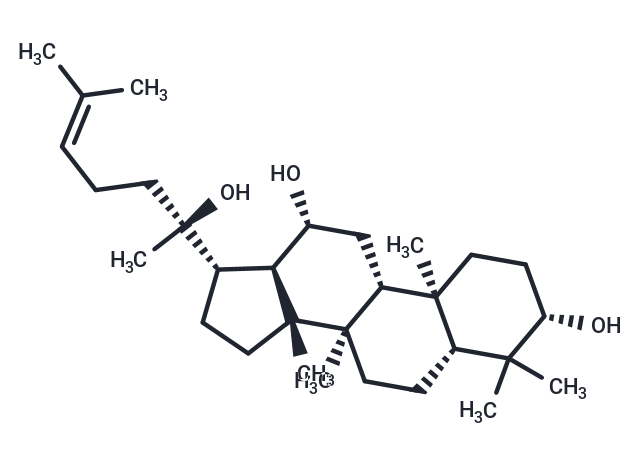Shopping Cart
- Remove All
 Your shopping cart is currently empty
Your shopping cart is currently empty

(20S)-Protopanaxadiol (20-Epiprotopanaxadiol) (20-Epiprotopanaxadiol), an apoptosis inducer, is an aglycon metabolic derivative of the protopanaxadiol-type ginseng saponin.

| Pack Size | Price | Availability | Quantity |
|---|---|---|---|
| 5 mg | $45 | In Stock | |
| 10 mg | $64 | In Stock | |
| 50 mg | $243 | In Stock | |
| 100 mg | $366 | In Stock | |
| 1 mL x 10 mM (in DMSO) | $46 | In Stock |
| Description | (20S)-Protopanaxadiol (20-Epiprotopanaxadiol) (20-Epiprotopanaxadiol), an apoptosis inducer, is an aglycon metabolic derivative of the protopanaxadiol-type ginseng saponin. |
| In vitro | Concentrations causing growth inhibition of 50% of cells (LC50) for the compounds (20S)-Protopanaxadiol is 23 μg/ml, for Int-407 cells. The the LC50 for (20S)-Protopanaxadiol is determined to be 24 μg/ml in Caco-2 cells. In the Int-407 cell line, (20S)-Protopanaxadiol produces great percentage of sub-G1 (apoptotic) cells(The Int-407 cell line is a human embryonic nonmalignant cell line originating from fetal tissue of approximately 2 months gestation, whereas Caco-2 is a human colon adenocarcinoma cell line). This response is attributed to differences in individual ginsenoside glycosylation and, thus, the hydrophobic-hydrophilic balance [2]. Incubation with (20S)-Protopanaxadiol also significantly reduces the viability of U251-MG and U87-MG cells in a dose- and time-dependent manner. The cytotoxic effect of (20S)-Protopanaxadiol is accompanied by reduced expression of cell adhesion proteins, including N-cadherin and integrin β1, which leads to reduced phosphorylation of focal adhesion kinase. Furthermore, incubation with (20S)-Protopanaxadiol reduces the expression of cyclin D1 and subsequently induces cell-cycle arrest at the G1 phase[3]. |
| In vivo | Treatment with (20S)-Protopanaxadiol and PPT prior to immobilization stress increase the time spent in open arms and open arm entries in the elevated plus-maze (EPM) test. Treatment with (20S)-Protopanaxadiol potently suppresses immobilization stress-induced serum levels of corticosterone and interleukin (IL)-6 by the enzyme-linked immunosorbent assay. (20S)-Protopanaxadiol and PPT may exhibit the anxiolytic effect via γ-aminobutyrateA (GABAA) receptor(s) and serotonergic receptor(s), respectively, and (20S)-Protopanaxadiol may have an anti-inflammatory effect that is more potent than that of PPT[1]. |
| Cell Research | Int-407 and Caco-2 cells are seeded at a concentration of 1×106 cells/mL in 24-well plates in separate experiments. Test ginsenosides (PPD, PPT, Rh2) are added to wells to the LC50 concentration determined previously from the MTT assays. The ginsenoside concentrations used for Int-407 cells are 23, 26, and 53 μg/mL, respectively, for PPD, PPT, and Rh2. In a similar experiment using Caco-2 cells, 24 μg/mL for both PPD and PPT and 55 μg/mL for Rh2 is used. Untreated cells represented the control. Cells are incubated at 37℃ in a 5% CO2 humidified incubator for 24, 48, and 72 h. Cell-free supernatant are obtained by centrifugation(400 g) for 10 min, and the lactate dehydrogenase (LDH) assay is conducted as previously reported.(Only for Reference) |
| Alias | 20-Epiprotopanaxadiol, 20(S)-APPD |
| Molecular Weight | 460.73 |
| Formula | C30H52O3 |
| Cas No. | 30636-90-9 |
| Smiles | CC(C)=CCC[C@](C)(O)[C@H]1CC[C@]2(C)[C@@H]1[C@H](O)C[C@@H]1[C@@]3(C)CC[C@H](O)C(C)(C)[C@@H]3CC[C@@]21C |
| Relative Density. | 1.036 |
| Storage | Powder: -20°C for 3 years | In solvent: -80°C for 1 year | Shipping with blue ice. | ||||||||||||||||||||||||||||||||||||||||
| Solubility Information | Ethanol: 31 mg/mL (67.28 mM), Sonication is recommended. DMSO: 85 mg/mL (184.49 mM), Sonication is recommended. H2O: < 1 mg/mL (insoluble or slightly soluble) | ||||||||||||||||||||||||||||||||||||||||
Solution Preparation Table | |||||||||||||||||||||||||||||||||||||||||
Ethanol/DMSO
DMSO
| |||||||||||||||||||||||||||||||||||||||||

Copyright © 2015-2025 TargetMol Chemicals Inc. All Rights Reserved.